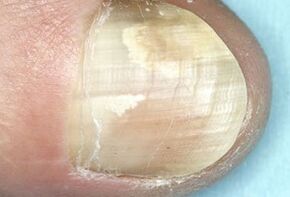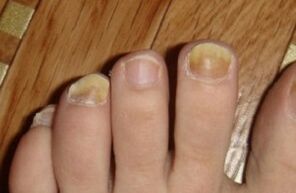
The nail plate fungus on the toes (onychomycosis of the foot) is a contagious disease shown in nail damage by dermatomycetes, mold or fungus such as yeast.According to statistics, the prevalence of the disease in the population reaches 10%.
The risk of foot onychomycosis contract directly depends on the social and residential conditions of one's residence, gender, age, profession, and the presence or absence of other diseases.
One way or another, due to its high tension and ability to worsen the quality of the patient's daily life, this pathology requires timely detection and competent comprehensive treatment.
Symptoms of toenails fungus
Depending on the manifestation of the symptoms, there are three types of foot onychomycosis:
- hypertrophic;
- normotrophic;
- atopic.
Hypertrophic damage to the nails is characterized by significant thickening and deformation of the nail plate, the loss of shining and the appearance of a "corrosion" on their side.The clinical picture of the disease can be supplemented by the appearance of pain and the development of onychoryphosis (a pathology in which nails take the appearance of bird claws).
With onychomycosis of normotropic types, yellow or white stripes and spots -spots appear on the nail plate.At the same time, nails maintain their configuration, shine and their thickness.With atopic onychomycosis, the nail plate quickly separates from the nail bed, becoming boring and obtaining gray-brown.The exposed skin area becomes covered with loose hyperkeratotic layers.
The clinical signs of the toenail's fungus form the basis of other onychomycosis classifications, which are used mainly by foreign doctors.Based on this typology, 4 forms of disease can be distinguished:
- distal (damage to nail -free edges);
- proximal (damage to posterior nail folds);
- lateral (damage to nails from the side);
- Total (damage to the entire nail plate).
The severity of the manifestation of onychomycosis must be taken into account when creating a therapeutic program.
Toenail fungus treatment

The diagnosis of "foot onychomycosis" is made based on visual medical examination, PCR tests, microscopic and cultural studies.Conducting the above tests allows us to draw conclusions not only about the presence of fungal infections, but also on the type of pathogen.
Now a few words on how to cure the toenail's fungus in the shortest possible time.The etiotropic treatment program for onychomycosis involves the use of local and systemic drugs.The most effective way for the treatment of local fungus on the toenail plate is:
- Antifungal keratolytic ointment, gel and cream;
- plaster specific to the mechanical removal of the affected nails;
- Antifungal varnish based on ciclopirox, amorolfine or salicylic, benzoic, lactic acid and resorcinol mixture.
Today, systemic therapy for nail fungus seems to be the most relevant.In recent years, several general antimicrobial drugs have been developed that can increase the effectiveness of onychomycosis treatment by up to 90%.
Medicine for toenail fungus
Varnis is considered the most effective antimicrotic varnish.The main feature of the product is their ability to destroy the pathogen in the nail layer and penetrate the nail bed.Cream and antifungal ointment include products containing terbinafine.The products listed are used daily for the affected and slow nail plate -the slices are applied until they are fully absorbed.The duration of treatment for onychomycosis with ointment and cream can change between 2-6 weeks.The procedure for using topical antifungal agents should be previously agreed with a dermatologist.
The selection of systemic medicines is carried out taking into account the severity of the disease and the presence or absence of contraindications for its use in patients.
Prevention of toenails fungus
The main steps aimed at preventing the development of foot onychomycosis are:
- prevent mechanical trauma to the nail plate;
- refusal to wear coarse, tight and inappropriate shoes;
- meticulous pedicure processing;
- the use of individual shoes while visiting baths, sauna and swimming pools;
- monitoring the health status of the pet, timely treatment of the pathology identified;
- excluding cases of using other people's bathing, clothing, towels and shoes;
- timely detection and treatment of diseases;
- Carry out activities aimed at strengthening the body's immune system.
It is important to understand that onychomycosis self -treatment often fails to achieve the desired results, but also complicates the disease.Therefore, before using medicines or folk medicine for fungus, you should coordinate treatment programs with experienced dermatologists.























